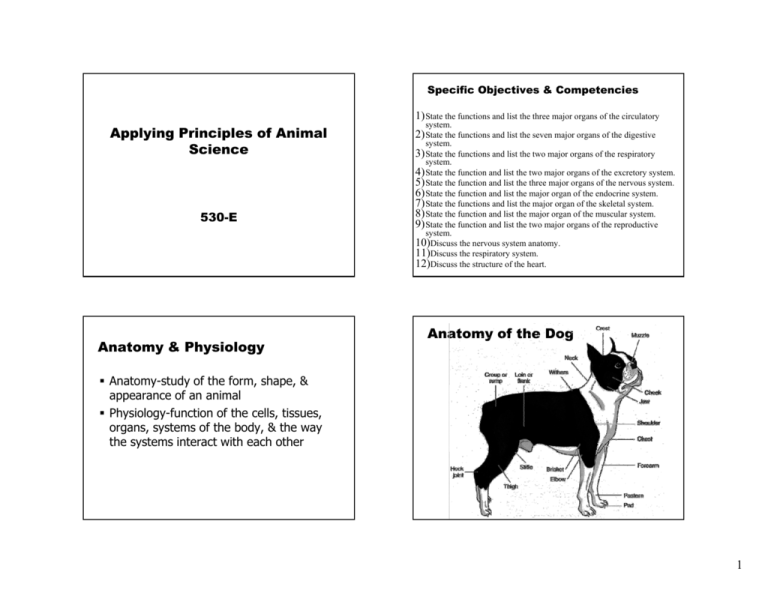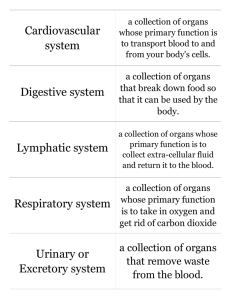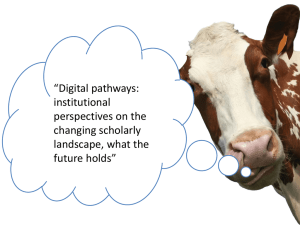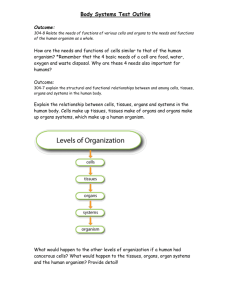
Specific Objectives & Competencies
1) State the functions and list the three major organs of the circulatory
Applying Principles of Animal
Science
system.
2) State the functions and list the seven major organs of the digestive
system.
3) State the functions and list the two major organs of the respiratory
system.
530-E
4) State the function and list the two major organs of the excretory system.
5) State the function and list the three major organs of the nervous system.
6) State the function and list the major organ of the endocrine system.
7)) State the functions and list the major organ of the skeletal system.
8) State the function and list the major organ of the muscular system.
9) State the function and list the two major organs of the reproductive
system.
10)Discuss the nervous system anatomy.
11)Discuss the respiratory system.
12)Discuss the structure of the heart.
Anatomy & Physiology
Anatomy of the Dog
Anatomy-study
Anatomy study of the form, shape, &
appearance of an animal
Physiology-function of the cells, tissues,
organs, systems of the body, & the way
the systems interact with each other
1
Anatomy of the Cat
Anatomy of the Rabbit
Anatomy of the pig
Anatomy of the Horse
2
Anatomy of the Cow
Anatomy of the Chicken
Major Organ Systems
Skeletal System
Skeletal System
Muscular System
Nervous System
Circulatory System
Respiratory System
Excretory System
Digestive System
Reproductive System
Mammary System
Composed of bones and cartilage
Protects organs
Supports body
Enables movement
3
Cartilage
Found at the ends of bones
acts as lubricant
acts as shock absorber
protects bones from wear damage
Bones
Bone Marrow
Made primarily of calcium & phosphorous
Made of several layers
Red marrow
outer membrane- contains blood vessels
compact bone-mineral rings & protein fibers
spongy bone-red & yellow marrow
creates new blood cells
helps with animal health
Yellow Marrow
energy reserve for the body
4
Skeleton of the
Chicken
Skeleton of the Pig
Skeleton of the Horse
Muscular System
Largest system in the body
45% of the weight
Important in movement:
locomotion
circulation
digestion
breathing
Made up of muscles and connective tissues
tendons connect muscles to bones
5
Major Muscle Types
Voluntary
controlled by cerebrum
signals must be sent for movement of
these muscles
Involuntary
automatically controlled by the lower parts
of the brain
operates the heart, intestines, lungs and
other automatic body systems
Nervous System
Nerve tissue that carries signals from
brain to muscles
Most highly developed system in the body
Helps body work as a single unit
3 parts
Muscling on a
Market Steer
Central Nervous System
Autonomic nervous System
Peripheral Nervous System
6
Nervous Systems
Nerve Cells
This photomicrograph shows a number of multipolar nerve cells. The central cell body is clearly visible in each of the
cells, as are the dendrites. The dendrites are short extensions of the nerve cell body that function in the reception of
stimuli. Oxford Scientific Films
"Nerve Cells," Microsoft® Encarta® 98 Encyclopedia. © 1993-1997 Microsoft Corporation. All rights reserved.
7
The Three Systems
Central Nervous System
y
-brain and spinal cord
Autonomic Nervous System
-controls involuntary muscles and organs
Peripheral Nervous System
-control of voluntary muscle control
Receptors
•5 senses collected through receptors of the nervous
system
•Neurons sense stimuli and send a signal to the brain
for processing
•5 Senses
•sound
•sight
•smell
•taste
•touch
Circulatory System
Moves blood, digested food, oxygen,
wastes, and other materials around the
body
Movement of blood around the body is
known as systemic circulation
Filtered through the liver and spleen
8
Blood Composition
Red Blood Cells
Plasma
90% water
Dissolved Substances
glucose, vitamins, minerals, amino acids
Solids
Red & white blood cells
made in the red bone marrow
contain hemoglobin
more numerous than white blood cells
cannot repair themselves
carry dissolved oxygen
Platelets
responsible for clotting
White blood Cells
Fight disease
collect at sites of infection or injury
pus is actually white blood cells
Parts of the Circulatory system
Heart
four
f
chambered
h b d pump
Arteries
carry blood away from the heart
Capillaries
small branches that carryy blood to individual cells
Veins
carry blood to the heart
9
Capillaries
Capillary Network
A web of tiny blood vessels branches from arterioles to bring blood to every tissue in the body. These small capillaries
reconverge, forming larger and larger vessels that take deoxygenated blood (blue) back to the heart.
Microsoft Illustration
"Capillary Network," Microsoft® Encarta® 98 Encyclopedia. © 1993-1997 Microsoft Corporation. All rights reserved.
Respiration
Moves gasses to and from the circulatory
system
2 types
INTERNAL-gas exchange between cells and blood
EXTERNAL-gas exchange between lungs and
blood
10
Parts of the Respiratory
System
Respiration
Nostrils
warm, filter,
fil
and
d moisturize
i
i air
i
Pharynx
connects nose to throat
Larynx
“voice box”
Trachea
“wind pipe”
Lungs
gas exchange organs
Human Lungs
Though the right lung has three lobes, the left lung, with a cleft to accommodate the heart, has only two. The two
branches of the trachea, called bronchi, subdivide within the lobes into smaller and smaller air vessels. They
terminate in alveoli, tiny air sacs surrounded by capillaries. When the alveoli inflate with inhaled air, oxygen
diffuses into the blood in the capillaries to be pumped by the heart to the tissues of the body, and carbon dioxide
diffuses out of the blood into the lungs, where it is exhaled. Microsoft Illustration "Human Lungs," Microsoft®
Encarta® 98 Encyclopedia. © 1993-1997 Microsoft Corporation. All rights reserved.
Breathing Process
Rate Control
Inspiration
As cells burn more oxygen they release
more carbon dioxide
Nerves sense the carbon dioxide and send
a signal to the brain to more oxygen and
expel more carbon dioxide
when carbon dioxide levels drop the rate
of breathing slows back down
taking air in
Gas is exchanged via osmosis
Expiration
pushing air out
11
Excretory System
Rids to body of wastes from metabolic
processes
maintains the balances of water and blood
Major items Excreted
carbon dioxide
water
nitrogen
toxins
Parts of the Excretory System
Skin
perspiration
temperature regulation
Kidneys
Filter the blood
Excrete urine
Bladder
storage of urine
Urethra
Digestive System
Two major types
Ruminant
Non-ruminant
N
i
t
simple
cecum fermenters
Prepares food for use by the body
Large complex molecules broken down
i t simpler
into
i l molecules
l
l
Long tube beginning with mouth and
ending with the anus
tube that carries urine out of the body
12
Parts
Mouth
where food enters the system
usually teeth and jaws chew the food into smaller
pieces
salivary glands secrete saliva into the mouth and it
is mixed into food by the tongue
saliva starts digestive process and makes
swallowing easier
Parts cont.
Digestive Tract of the Pig
Esophagus
connects the mouth with the stomach
moves food into the stomach by swallowing
swallowing occurs when muscles around the
esophagus contract sequentially to move the food
Simple or true stomach
food mixed with digestive juices
13
Digestive Tract of the Horse
Parts cont.
Ruminants
Ruminants--four
four chambered stomachs
Rumen
largest of the four compartments
houses billions of bacteria
regurgitated food chewed and re-swallowed to
break up
p large
g pieces
p
grains must be broken or they will not be digested
when small enough food passes from rumen into
reticulum
Ruminants cont.
Reticulum
et cu u
stores food and sorts out foreign materials
“honeycomb” like structure
Omasum
strong walls further break up particles before
passing them on
it squeezes the fiber and sends larger pieces back
to rumen
Abomasum
same functioning as true stomachs
14
Parts cont.
Parts cont.
Small Intestine
Hind-gut
Hind gut
most of the absorption occurs here
majority of that absorption occurs in the upper 1/3
of the small intestine
absorption is process by which the end products of
digestion move into the blood
bile secreted here breaks down fats for later
digestion
Advantages of Ruminants
Cecum & Large Intestine
cecum stores fiber for partial digestion
large intestine removes water and forms the feces
Anus
opening
i through
th
h which
hi h the
th feces
f
leaves
l
the
th body
b d
Poultry Digestion
Can consume & digest large quantities of
roughage
Able to turn low quality range land into
high quality food
Don’t require grains as source of energy
15
Parts of the Poultry Digestive
System
Reproductive System
Reproduction
&
Mammary Glands
Birds do not have teeth
Crop—enlargement of the esophagus, serves primarily as
th storage
the
t
area for
f food,
f d some softening
ft i does
d
occur
Ventriculus—AKA the gizzard, grinds and crushes food,
horny lined structure that is heavily muscled, birds fed
coarse feeds to aid in this process, in the wild they may eat
small rocks or gravel
Small intestines—most absorption takes place in the
bottom of the small intestines
Ceca—two
Ceca two blind pouches
pouches, function unknown
Large Intestine—same as in other animals
Cloaca—junction for the digestive, urinary, and genital
systems
Vent—external opening where waste and eggs are
excreted.
Function—Produce sex cells
Produce milk for offspring
Major Organs
Mammary Glands
Ovaries
Uterus
Testes
What are the Male
Reproductive Organs?
Conditions for Fertilization
Anatomy of Male & Female must be
co pat b e
compatible
Female must be in Heat
Egg must be mature
What is the function of the
Male?
produce large numbers of live sex cells
(spermatozoa)
contribute 1/2 chromosomes
Testicles - p
produce spermatozoa
p
& male
hormone Testosterone
Scrotum - sack which carries testicles
functions as a heat regulator
Epididymis - tube connects to testes
storage of spermatozoa (200 billion at a time)
spermatozoa mature as they migrate through
Vas Deferens - tube connects to epididymus
16
What are the Male Reproductive
Organs?
Urethra - begins at bladder and
continues through penis
Sigmoid Flexure - "S" shape in urethra
allows for extension of penis outside of
body for reproduction
Accessory Sex Glands
What is the function of the
Accessory Sex Glands?
provide medium for transporting
sperm
adds volume
provides nutrients
cleans & flushes urinary tract
prostate
two seminal vesicles
two cowpers glands
What is the function of the
female?
contribute 1/2 chromosomes
care for young in uterus during pregnancy
and after birth until weaning
17
What are the Female
Reproductive Organs?
What are the Female
Reproductive Organs?
Vulva - exterior portion of reproductive
tract
provides visual signs of heat
Vagina - between vulva & cervix
Cervix - "Mouth
Mouth of the womb
womb"
opening into uterus
at birth cervix stretches to allow baby to
pass (most painful part)
during pregnancy cervix becomes blocked
with a mucous plug to prevent infection
Cows & Ewes: semen is deposited
p
here
Mares & Sows: semen is deposited in the
cervix
What are the Female
Reproductive Organs?
Uterine Horns - two branches of uterus
Fallopian Tube - uterine horn becomes a
small tube
lined with cilia which aid in egg migration
Ovaries
located at end of fallopian tubes
possesses large number of eggs in all
stages of development
this is all the eggs she will ever have,
unlike the male
very few eggs reach maturity
if not fertilized, the egg is reabsorbed by
the body
18
Reproduction in Males
After sexual maturity, sperm production is
continuous
Testosterone is responsible for:
growth, development & activity of accessory
glands
survival of spermatozoa
secondary sex characteristics:male voice, sex
drive
Reproduction in Males
Reproduction in Females
Semen - collective term for all fluid
ejaculated
sperm and fluid from accessory
glands
Farm animals reach sexual maturity at 4
months (sow) to 24 months (mare), then
Female comes in heat (estrus)
Egg released by ovary
Egg travels down tube until fertilized by
sperm
Estrogen - female hormone which
regulates estrus
19
What does "in heat" mean?
Heat is the time when a female is
receptive to the male and will allow
breeding to take place
Heat is actually divided into 4 phases of
the cycle.
Females also show external
signs of "Heat"
aggressive behavior
swelling and/or color change of vulva
Estrous Cycle:
Proestrus: ovary is about to release an egg
Estrus: female receptivity
Metestrus: uterus prepares for pregnancy
fertilized egg attaches to uterus
Diestrus: longest period of cycle
inactive
Estrous Cycles stop after conception, and begin
soon after Parturition (birth)
Mammary System
Only developed in female animals
Consists of many milk producing glands
Consists of millions of small alveoli which
produce the milk
Blood passes around the alveoli and they
take nutrients and produce the milk
20
Lactation:
•Producing milk for the
young. Lasts through weaning
(weeks to months)
•Weaning:
g when young
y
g can eat
•age
other foods
Alveoli
Source: Scientific Farm
Animal Production 4th Edition
Robert E Taylor
21










